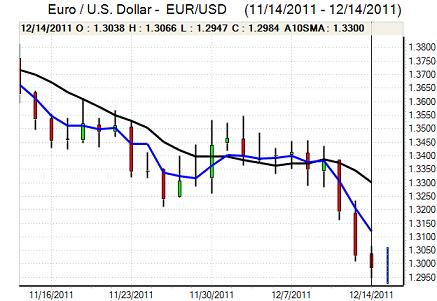EUR/USD
The Euro briefly bounced to the 1.3050 area against the dollar on Wednesday, but buying lacked conviction and it was subjected to renewed selling pressure once the 1.30 technical support level was broken.
There were further concerns over last week’s EU Summit on political and economic grounds. Several non-euro-zone countries expressed doubts surrounding the proposed legislative changes and there were persistent fears that there would be no economic back-up for the fiscal commitments.
Bundesbank Head Weidmann again opposed any form of monetary financing by the ECB with a stark warning over the need to maintain central bank independence and avoid printing money. He also stated that there was growing scepticism surrounding the peripheral bond buying programme within the ECB and was also cautious over the prospect of boosting IMF funding.
There was a further increase in Italian yields at the latest bond auction which maintained fears surrounding the peripheral economies. There was another warning that Greece would miss its 2011 targets on growth and the budget with markets increasingly fearful over the implications of continuing recession as talks on a second rescue package and private-sector debt restructuring continued.
Risk appetite deteriorated during the day as equity markets fell and there was further speculation over a liquidation of non-dollar holdings as conditions within the money markets continued to tighten. There was also substantial selling pressure on commodities which helped support the dollar.
There were further concerns over the US fiscal policies with continuing congressional battles over whether to extend a payroll tax holiday which is due to expire at the end of 2011. The Euro retreated to lows around 1.2950 before recovering slightly with aggressive selling curbed by reports of substantial option barriers around the 1.29 level.

Source: VantagePoint Intermarket Analysis Software
Call now and you will be provided with FREE recent forecasts
that are up to 86% accurate* 800-732-5407
If you would rather have the recent forecasts sent to you, please go here
Yen
The dollar was able to resist a test of support during Wednesday and strengthened to a high around 78.15 against the yen, although there was still a lack of momentum surrounding the move. Both currencies continued to be influenced strongly by trends in risk appetite and underlying concerns over the outlook was an important factor underpinning demand as the yen tested levels close to 101 against the Euro.
The headline Japanese Tankan business confidence index weakened to -4 in the latest quarter from 2 previously, maintaining fears surrounding the industrial outlook, especially with capital spending plans weak, but there was a stronger than expected reading for the services sector.
Sterling
Sterling was unable to make headway much above 1.5520 against the dollar on Wednesday even with better than expected data and tested 2-month lows around 1.54 before finding some respite. Dollar moves dominated during the day as Sterling strengthened to a fresh nine-month high beyond 0.84 against the Euro before correcting slightly.
The UK unemployment claimant count increase was lower than expected for November at 3,000 following a revised 2,500 increase the previous month, but there was an underlying increase in unemployment to a 17-year high which maintained unease over the economy. Markets are also expecting a weak retail sales reading on Thursday.
There was further evidence of safe-haven demand for UK government bonds, although the latest auction did see a lower than expected bid/cover ratio which could suggest that demand is fading at current yields.
There was also still speculation that the Bank of England would sanction additional quantitative easing next year which curbed Sterling buying support.
Swiss franc
The franc weakened against the Euro on Wednesday with a move towards the 1.24 level and, with the Euro under wider selling pressure, the dollar was able to attack 10-month highs above 0.95.
The Swiss ZEW business sentiment index weakened to -72.0 for November from -64.3 previously while there was a larger than expected decline in producer prices of 0.8% for the month which maintained underlying concerns over the threat of recession and deflation.
In this context, there was further speculation that the National Bank could announce an increase in the minimum Euro level from the 1.20 level at Thursday’s policy meeting, although uncertainty remained very high.

Source: VantagePoint Intermarket Analysis Software
Call now and you will be provided with FREE recent forecasts
that are up to 86% accurate* 800-732-5407
If you would rather have the recent forecasts sent to you, please go here
Australian dollar
The Australian dollar was blocked below 1.0050 against the US dollar on Wednesday and was subjected to further selling pressure during the day with lows near 0.9860. The firm US tone was compounded by a sharp decline in gold and commodity prices which undermined the Australian currency.
There were also fears surrounding the regional growth outlook and the threat of de-leveraging which would tend to hurt the Australian currency. There was some relief in Asian trading on Thursday as there was a small rebound in the Chinese PMI index even though it remained below the pivotal 50 level. The domestic influences were limited with inflation expectations little changed, although there was speculation over further interest rate cuts in the first quarter of 2012.



